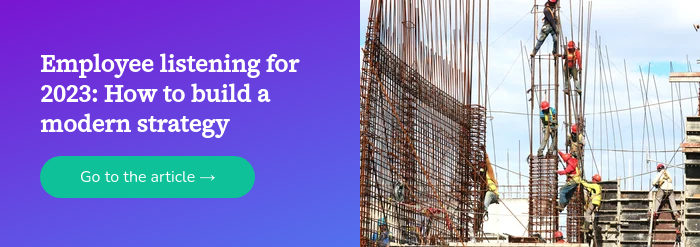How do you engage with your frontline? Pulse surveys and opinion polls? Email newsletters and town halls? Focus groups and notice boards?
Large companies employ a wide range of methods to diffuse their message internally, but 55% of frontline workers engage with company comms less than once a month and only 15% of employees understand the rationale behind company strategy.
That status quo isn't working for either leaders or the frontline. To cascade your message effectively (and get useful frontline feedback in return), you need a modern employee listening platform.
5 ways to cascade your message effectively with a modern employee listening platform
Two-way, not top-down. Do you feel like you’re sending messages into outer space? Frontline workers don’t engage with cold corporate broadcasts and top-down emails - 83% of frontline workers don’t even have a company email address. But frontline workers do engage when they can respond to leaders directly. Using a platform with two-way dialogue not only shows that you value frontline opinions, but also helps improve your initiatives by garnering constructive feedback.
Over time, not a point in time. Do you send out polls to gauge opinion on your initiatives? Sporadic one-time engagement at best captures employee’s attention at one point in time, at worst gets ignored completely. What’s more, one-time messaging fails to track changing employee sentiment - what might be popular in the summer is not necessarily popular in the winter. A modern employee listening platform enables you to track how your message is landing over time and address evolving employee concerns. It’s like an ‘open door’ policy that employees actually use.
Protected, not exposed. How often have you received direct responses to corporate emails or newsletters? Instead of asking for workers to put their head above their parapet, a modern employee listening platform provides a safe space for leaders to post messages and employees to respond. The platform’s optional anonymity and independent moderation surfaces more diverse opinions, so you don’t always hear from the same louder voices, and enables workers to give feedback in multiple ways. For example, they can create a post on a topic, comment on a post or use emojis to signal approval or disagreement.
One rung, not a ladder. How many management layers does your company have between senior leadership and the frontline? In the traditional ladder of leadership-frontline connection, your message can be delayed or misinterpreted at every strata. But with a modern employee listening platform, leaders can cut out the middlemen and speak to the frontline directly. This not only helps diffuse messages about complex changes - i.e. merging departments or changes to pension schemes - but also enables leaders to forge a stronger bond with the workforce.
Meaningful, not meaningless. Ever sent an email that doesn’t make sense when read back? 86% of leaders think they send meaningful communications to their workers, but 59% of workers say the communications aren’t useful. To ensure your message is heard and has a positive impact, it needs to be relevant to employee concerns. A modern employee listening platform not only surfaces priority concerns, but also flags sensitive posts and advises leaders how to respond. This way, your message is always on point, and always lands.
Put yourself in the frontline’s shoes
Put yourself in your frontline’s shoes: how would you prefer to receive senior leader messages? Cold one-way emails, unmoderated forums and impersonal broadcasts? Or a moderated, anonymised platform where your opinion is valued and you can engage with leaders directly?



